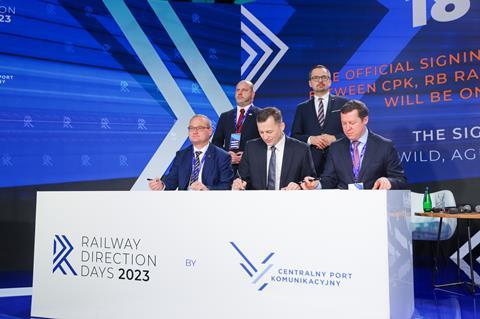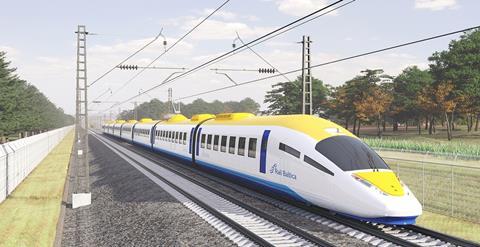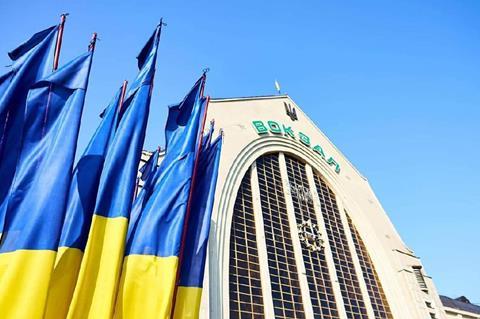
EUROPE: Memoranda of understanding for co-operation to co-ordinate the development of Poland’s Centralny Port Komunikacyjny transport project with the ongoing Rail Baltica, the proposed V4 high speed line which would link the capitals of the four Visegrád countries, and a future standard gauge line to Kyiv were signed at the Railway Direction Days 2023 conference in Warszawa.
Plans are being developed for almost 4 500 km of high speed and cross-border railways to be built in the ‘Three Seas’ region between the Baltic, Black and Adriatic seas by 2050.
A report by consultancy Steer which was presented at the conference estimates the total cost at €60bn and the benefits at more than €120bn; this would include €55bn of passenger journey time savings and €57bn of other benefits including a €9bn decrease in accidents and €9m reduction in traffic congestion.
Steer estimates that the busiest sections of the proposed network would be Warszawa – Łódź, Brno – Jihlava and Budapest – Győr, each carrying between 14 and 18 million passengers/year.
‘These rail projects are tailored to the needs of individual countries and the Three Seas region as a whole’, said Marcin Horała, the Polish government’s plenipotentiary for the CPK project. The projects ‘will form the future railway backbone of the Three Seas region and an important part of the European TEN-T transport network’.
Three Seas network
Feasibility studies are underway for 1 500 km of the 2 000 km CPK links, including the 140 km Warszawa – Łódź and 200 km Łódź – Wrocław high speed lines.

CPK envisages that preparatory work for Warszawa – Łódź link could start in H2 2023 for opening with the first phase of a planned airport in 2028.
In parallel, Polish infrastructure manager PKP PLK is to modernise the route from Warszawa to Białystok and a connection with Rail Baltica at the Lithuanian border.
The plan envisages that the first sections of Rail Baltica will open in 2027, with the whole corridor completed in 2030.
A section of the proposed V4 high speed line between Praha, Brno, Bratislava and Budapest would also be built at this time, with Katowice – Ostrava and Małopolska – Śląskie connections in Poland following later.
| Three Seas high speed rail network projected journey time savings | ||
|---|---|---|
| Cities | Current journey time, h | Future journey time, h |
| Łódź – Wrocław | 3 | 1 |
| Warszawa – Vilnius | 9 | 4 |
| Warszawa – Riga | >8 | 5 |
| Warszawa – Ostrava | 4½ | < 2 |
| Warszawa – Budapest | 11½ | 5½ |
| Praha – Wien | 4½ | 2 |
| Praha – Budapest | 7 | 3½ |
Rail Baltica, CPK and V4

On January 18, the Rail Baltica project co-ordinator RB Rail, Poland’s CPK and Czech infrastructure manager SŽ signed a MoU for co-operation.
This includes knowledge sharing in areas including traffic forecasting, investment models, joint planning of timescales and preparatory works and common action to promote high speed rail at the EU and international levels.
RB Rail management board Chair Agnis Driksna said the scale of Rail Baltica and its European impact means it must co-operate with other megaprojects. ‘Not only we can learn from each other, but through this co-operation we can together enhance better solutions for mobility, connectivity, business development and economic growth in northeast and central Europe’, he said.
CPK CEO Mikołaj Wild said ‘this is the unique, one-of-a-kind time in our common history when, functioning together in the region, we can create an unrivalled rail transportation offering. We are drawing lessons from high speed rail investments in the west. As a result, our projects can bring about an economic domino effect, giving a boost to other industries and sectors.’
Ukraine and CPK

CPK and Ukrainian national railway Ukrzaliznytsia signed a three-year agreement for co-operation in the construction of new transport infrastructure and reconstruction of Ukraine’s rail network once the war is over.
Objectives include the development of 1 435 mm gauge cross-border connections meeting EU technical standards, along with the joint preparation of a feasibility study for a 250 km/h line linking Warszawa, Lviv and Kyiv. CPK and UZ will jointly seek EU funding for the line which would be an extension of CPK Spoke 5.
‘Today’s agreement aims to improve railway links between Ukraine, Poland and the EU, facilitate passenger traffic, improve economic exchange and strengthen the safety of our transport corridors’, said Volodymyr Shemaev, Ukrzaliznytsia’s Director of International Projects. ‘I hope that co-operation with CPK will bring us closer to the construction of our first European gauge high speed line and will be an important step towards Ukraine’s integration with the EU.’

















